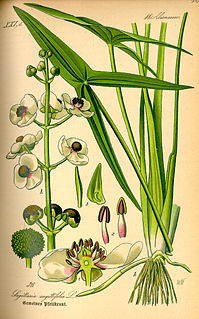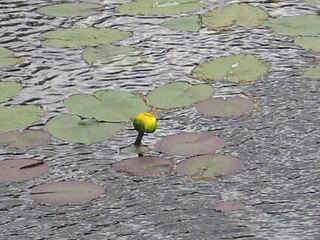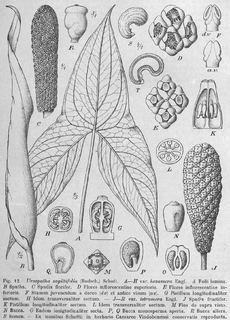
Magnolia is a large genus of about 210 flowering plant species in the subfamily Magnolioideae of the family Magnoliaceae. It is named after French botanist Pierre Magnol.

Firs (Abies) are a genus of 48–56 species of evergreen coniferous trees in the family Pinaceae. They are found through much of North and Central America, Europe, Asia, and North Africa, occurring in mountains over most of the range. Firs are most closely related to the genus Cedrus (cedar). Douglas firs are not true firs, being of the genus Pseudotsuga.

Caltha palustris, known as marsh-marigold and kingcup, is a small to medium size perennial herbaceous plant of the buttercup family, native to marshes, fens, ditches and wet woodland in temperate regions of the Northern Hemisphere. It flowers between April and August, dependent on altitude and latitude, but occasional flowers may occur at other times.

A botanical name is a formal scientific name conforming to the International Code of Nomenclature for algae, fungi, and plants (ICN) and, if it concerns a plant cultigen, the additional cultivar or Group epithets must conform to the International Code of Nomenclature for Cultivated Plants (ICNCP). The code of nomenclature covers "all organisms traditionally treated as algae, fungi, or plants, whether fossil or non-fossil, including blue-green algae (Cyanobacteria), chytrids, oomycetes, slime moulds and photosynthetic protists with their taxonomically related non-photosynthetic groups ."

Sagittaria is a genus of about 30 species of aquatic plants whose members go by a variety of common names, including arrowhead, duck potato, katniss, Omodaka, swamp potato, tule potato, and wapato. Most are native to South, Central, and North America, but there are also some from Europe, Africa, and Asia.

Nuphar is genus of aquatic plants in the family Nymphaeaceae, with a temperate to subarctic Northern Hemisphere distribution. Common names include water-lily, pond-lily, alligator-bonnet or bonnet lily, and spatterdock.

Peltandra, the arrow arums, is a genus of plants in the Araceae family. It is native to the eastern United States, eastern Canada, and Cuba.
- Peltandra sagittifolia - (Michx.) Morong - Spoon flower or the white arrow arum - southeastern US from eastern Louisiana to Virginia
- Peltandra virginica(L.) Schott - Arum arrow - Cuba, Quebec, Ontario, Oregon, California, Washington; eastern US from Maine to Florida, west to Texas, Kansas, and Minnesota
- †Peltandra primaeva – Eocene, Golden Valley Formation, North Dakota, USA

Sagittaria sagittifolia is a flowering plant in the family Alismataceae, native to wetlands most of Europe from Ireland and Portugal to Finland and Bulgaria, and in Russia, Ukraine, Siberia, Japan, Turkey, China, Australia, Vietnam and the Caucasus. It is also cultivated as a food crop in some other countries. In Britain it is the only native Sagittaria.

Orchis mascula, the early-purple orchid, is a species of flowering plant in the orchid family, Orchidaceae.

Monarda fistulosa, the wild bergamot or bee balm, is a wildflower in the mint family (Lamiaceae) widespread and abundant as a native plant in much of North America. This plant, with showy summer-blooming pink to lavender flowers, is often used as a honey plant, medicinal plant, and garden ornamental. The species is quite variable, and several subspecies or varieties have been recognized within it.

Aroideae is a subfamily of flowering plants in the Araceae family. It is the largest subfamily in Araceae and consists of about 72 different genera, and 2,300 species. Many Aroideae have spiny pollen grains without a sporopollenin outer exine layer and lacking an aperture.

Urospatha is a genus of flowering plants in the family Araceae that consists of approximately 10 known species. They are found growing in South America and Central America in swamps, wet savannahs, and brackish water. The leaves of the species in this genus are upward pointing and sagittate (arrow-shaped). The inflorescences are quite unique; the spathe is mottled and elongated with a spiral twist at the end. The seeds are distributed by water and have a texture similar to cork that allows them to float. They also quickly germinate in water.

Citrus macroptera, with English common names Melanesian papeda, wild orange, cabuyao, shatkora, hatkhora, hatxora or satkara, is a semi-wild species of citrus native to Malesia and Melanesia.
Spathantheum is a genus of flowering plants in the family Araceae. The genus contains two species, Spathantheum fallax and Spathantheum orbignyanum. Spathantheum is believed to be closely related to Spathicarpa. The genus is endemic to the Andes of Peru, Bolivia, and northern Argentina and is found growing in grasslands in rocky soil.
- Spathantheum fallax Hett., Ibisch & E.G.Gonç. - Bolivia
- Spathantheum orbignyanumSchott - Peru, northwestern Argentina, Bolivia

Spathicarpa is a genus of flowering plants in the family Araceae, all of which are endemic to South America. Spathicarpa species are notable for the fact that the entirety of their spadix is fused to the spathe. The genus is believed to be closely related to Spathantheum. The tribe Spathicarpeae is named after the genus Spathicarpa.

Malvella is a small genus of flowering plants in the mallow family, Malvaceae. There are four species, one native to the Mediterranean, and three native to the southwestern United States and Mexico. The plants were formerly classified in genus Sida.
Suddia is a genus of plants in the grass family. The only known species is Suddia sagittifolia, which is native to South Sudan in central Africa.
Peltandra sagittifolia is a species of plant in the genus Peltandra. It is commonly known as the spoonflower or the white arrow arum, native to the southeastern United States from eastern Louisiana to eastern Virginia.

















